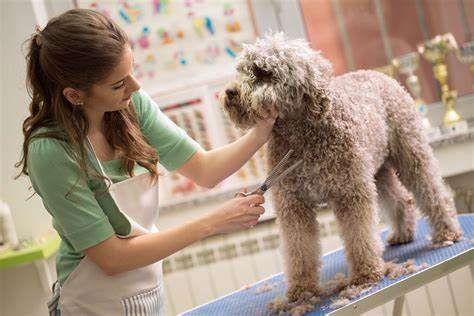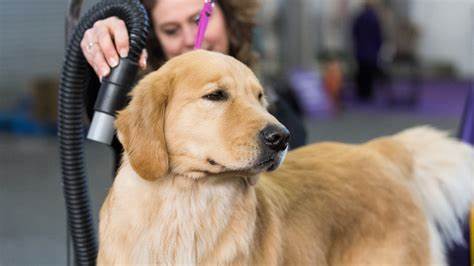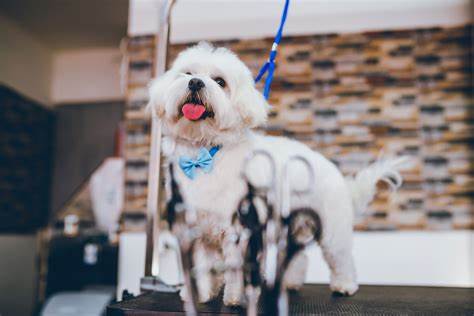Introduction
Begin by explaining the importance of grooming for puppies. Highlight how early grooming experiences can set the foundation for a lifetime of good hygiene and comfort. Emphasize the benefits of starting professional grooming at the right time, including socialization, health maintenance, and establishing a routine.
Why Grooming is Essential for Puppies
1. Health and Hygiene
- Preventing Matting and Tangles: Explain how regular grooming prevents matting and tangles, which can cause discomfort and skin issues.
- Detecting Health Issues: Discuss how grooming sessions provide an opportunity to detect health issues early, such as skin infections, parasites, or abnormalities.
2. Socialization and Behavior
- Positive Experience: Highlight the importance of introducing puppies to grooming as a positive experience, helping them become accustomed to being handled.
- Behavioral Benefits: Explain how early grooming can help reduce anxiety and fear associated with being touched or handled, making future grooming sessions easier.

When to Start Professional Grooming
1. Ideal Age to Begin
- 8 to 12 Weeks Old: Recommend starting professional grooming when the puppy is between 8 to 12 weeks old, after they have received their initial vaccinations.
- Gradual Introduction: Explain the importance of a gradual introduction to grooming, starting with short, positive sessions.
2. Signs Your Puppy is Ready
- Comfort with Handling: Discuss how to gauge if a puppy is comfortable with handling and touching, indicating they are ready for grooming.
- Calm Behavior: Highlight the importance of ensuring the puppy is calm and relaxed, as a stressed puppy may have a negative experience.
Choosing the Right Groomer
1. Researching Groomers
- Reputation and Reviews: Recommend researching groomers by checking online reviews, asking for recommendations from friends or veterinarians, and visiting potential groomers.
- Certification and Training: Discuss the importance of choosing a groomer with proper certification and training in handling puppies.
2. Visiting the Groomer
- Facility Tour: Suggest visiting the grooming facility to ensure it is clean, safe, and equipped for handling puppies.
- Meeting the Groomer: Emphasize the importance of meeting the groomer to discuss their approach to handling and grooming puppies.
Preparing Your Puppy for Grooming
1. Desensitization Techniques
- Handling Exercises: Provide tips on gradually introducing the puppy to being handled, touching their paws, ears, and coat to prepare them for grooming.
- Brushing Practice: Recommend starting with short brushing sessions at home to get the puppy used to the sensation and process.
2. Positive Reinforcement
- Treats and Praise: Explain the use of treats and praise to create a positive association with grooming activities.
- Short Sessions: Suggest keeping initial grooming sessions short and gradually increasing the duration as the puppy becomes more comfortable.
What to Expect During the First Grooming Session
1. Initial Consultation
- Health Check: Discuss how the first grooming session may include a health check to ensure the puppy is in good condition for grooming.
- Grooming Plan: Explain that the groomer will develop a grooming plan based on the puppy’s breed, coat type, and specific needs.
2. Basic Grooming Services
- Bathing and Brushing: Describe the basic grooming services included in the first session, such as bathing, brushing, and nail trimming.
- Ear Cleaning and Teeth Brushing: Highlight the importance of ear cleaning and teeth brushing as part of the grooming routine.

Benefits of Regular Professional Grooming
1. Maintaining Coat Health
- Regular Maintenance: Explain how regular grooming helps maintain the health and appearance of the puppy’s coat, preventing matting and tangles.
- Skin Health: Discuss the benefits of grooming for skin health, including removing dirt, debris, and dead skin cells.
2. Preventing Health Issues
- Early Detection: Highlight how groomers can detect early signs of health issues, such as infections, parasites, and abnormalities.
- Preventing Infections: Discuss how regular grooming helps prevent infections, particularly in areas prone to moisture and debris buildup, such as ears and paws.
Addressing Common Concerns
1. Puppy Anxiety
- Creating a Calm Environment: Provide tips on creating a calm environment for grooming to reduce anxiety, such as playing soothing music and using calming sprays.
- Gradual Acclimation: Emphasize the importance of gradually acclimating the puppy to grooming activities to reduce fear and stress.
2. Grooming Frequency
- Breed-Specific Needs: Discuss how the grooming frequency depends on the puppy’s breed and coat type, with some breeds requiring more frequent grooming than others.
- Seasonal Considerations: Explain how seasonal changes may affect grooming needs, such as increased shedding during spring and fall.
DIY Grooming Between Professional Visits
1. Home Grooming Routine
- Brushing and Combing: Recommend maintaining a regular brushing and combing routine at home to keep the coat healthy and reduce shedding.
- Bathing Tips: Provide tips for bathing the puppy at home, including using dog-specific shampoos and conditioners.
2. Nail Trimming and Ear Cleaning
- Safe Nail Trimming: Explain how to safely trim the puppy’s nails at home, using appropriate tools and techniques to avoid cutting the quick.
- Ear Cleaning: Discuss the importance of regular ear cleaning to prevent infections and how to do it safely at home.
Importance of Continuing Education
1. Staying Informed
- Grooming Trends: Encourage staying informed about the latest grooming trends and techniques to provide the best care for the puppy.
- Groomer Communication: Highlight the importance of maintaining open communication with the groomer to address any concerns and ensure the puppy’s grooming needs are met.
2. Learning from Experts
- Grooming Workshops: Suggest attending grooming workshops or classes to learn more about grooming techniques and best practices.
- Online Resources: Provide recommendations for online resources, such as videos and articles, to further educate on puppy grooming.

Case Studies and Testimonials
1. Real-Life Experiences
- Owner Testimonials: Share testimonials from puppy owners who have successfully introduced their puppies to professional grooming.
- Positive Outcomes: Highlight the positive outcomes and benefits of starting professional grooming early.
2. Case Studies
- Success Stories: Provide detailed case studies of puppies with specific grooming needs that were successfully managed through professional grooming.
- Before and After: Include before and after photos to illustrate the improvements in coat health and appearance.
Conclusion
Summarize the key points about when to start professional grooming for puppies, emphasizing the importance of early introduction, choosing the right groomer, and maintaining a regular grooming routine. Highlight the long-term benefits of professional grooming for the puppy’s health, comfort, and overall well-being.
Call to Action
Encourage readers to start researching and visiting potential groomers for their puppies and to share their experiences or additional tips in the comments section. Invite them to subscribe to the blog for more pet grooming tips and advice.
